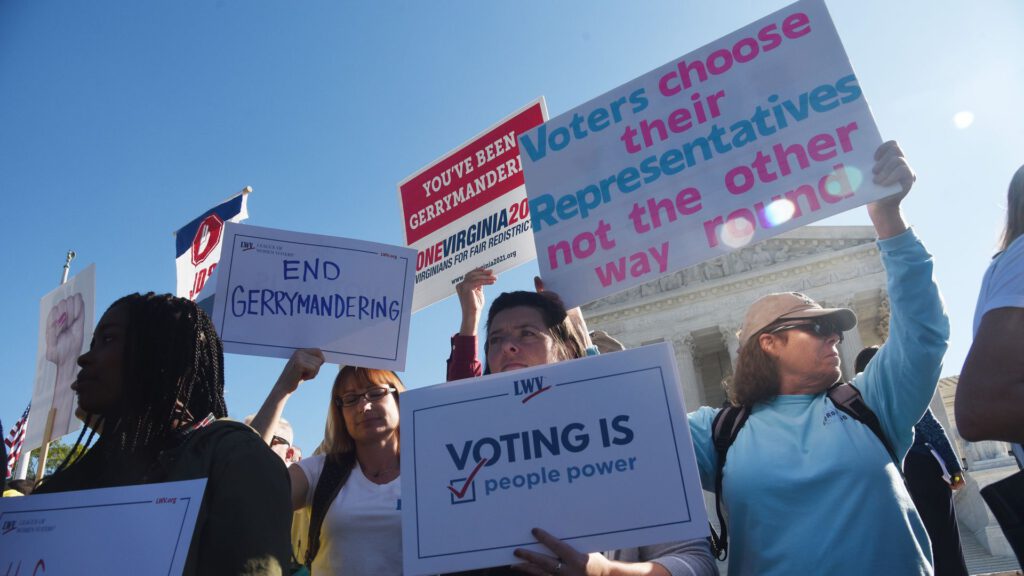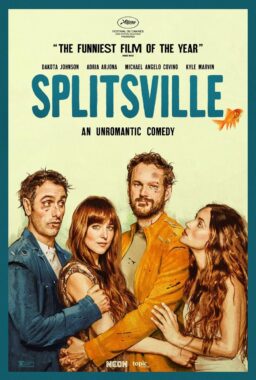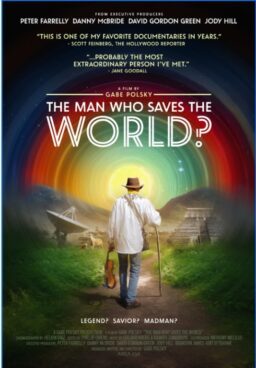“Slay the Dragon” is a terrifying look at efforts to undermine the most fundamental structures of democracy. Directors Barak Goodman and Chris Durrance include remarkably candid interviews, devastating data, and, thankfully, inspiring stories of fighting back a skillfully told and powerfully compelling documentary. It is available on demand April 3, 2020.
In an interview with RogerEbert.com the directors talked about being “advocates for democracy,” the power of social media in pushing back against dark money, and making the arcane, data-heavy story of gerrymandering accessible and cinematic.
How do you, as documentarians, draw the line between journalism and advocacy?
BARAK GOODMAN: We want to be advocates for democracy. We want to be advocates for fixing a system that’s very broken. But it is challenging to be nonpartisan when the story takes you in a certain direction. We show that gerrymandering historically is done by both parties. But the real heart of our film is about project REDMAP which was a Republican undertaking. So there’s a difference between being neutral and being objective. We wanted to be objective about the issue of gerrymandering but we had to look at this case where one party decided to and found a way to use gerrymandering as a national strategy. It’s not because the Republicans are more nefarious than Democrats in general but they cornered the market on this practice so we had to look at that fairly. But what we advocate for is the end of this practice for either party.
CHRIS DURRANCE: The name of Katy Fahey’s organization, Voters not Politicians, says it all that’s because many politicians have become insiders; they’ve become too tempted by the trappings of office and just too willing to do anything to stay in power. So that’s what the film’s about.
You had a very dense, arcane set of facts and you made it all very accessible, staring with the opening animation of the rolling red line. How did you work on communicating cinematically?
BG: We knew we had to lean on graphics for this because of the density in just getting across what gerrymandering is and so we spent a lot of time working both with the a very high-end firm out in L.A. but also with our own very talented in-house people. We knew we wanted to use actual maps and superimpose on top because every time you do that, it reinforces for the viewer just what this is. You can hear it described and it can just go in one ear and out the other. So we had to show it over and over again “This is what it is, this is how it works, you just move this over here and this line over there suddenly it turns red or it turns blue” and so we thought that would be the most effective way of getting it across. With the animal references inspired by the shapes of the gerrymandered districts, we wanted to emphasize the absurdity of the whole process and the outcome. Fortunately, these ridiculous districts had these funny anthropomorphic names so we used that as a device to help the viewer.

I was amazed at how candid Chris Jankowski was about adopting the strategy of using the post 2010 census to re-district explicitly to neutralize Democratic votes. He wasn’t just unapologetic; he was bragging about it.
CD: He’s a remarkable man, very smart, and absolutely proud of what he did. He did something that no one really has done before; he took control of a large number of states and basically the lower house of Congress for the best part of ten years and did it in a marathon political sense for peanuts (for about $30 million). So, he had that professional pride in what he’s done. And he’s a partisan so he’ll look at Wisconsin for example and the fact that he basically gave Wisconsin to Republicans for ten years and that is a good thing. The policies of Scott Walker and other Republicans he thinks of as a good thing for all the states. Other people have a differing opinion but that’s his take.
I think it is clear there’s a little bit of doubt that does creep into his mind occasionally. Perhaps that’s the best way of phrasing it. He’s not unreservedly proud of what he did. He does see that there’s something a little bit toxic, a little bit unfair. Coming into 2020 if that happened again there is a question about whether that would be healthy for democracy or as he said it would be gnawing away at the foundations and bad for all of us and I think that does creep into his mind occasionally.
You recognize that the motive to stay in power is a very strong factor, but how has this all been affected by Citizens United and people like the Koch brothers and Sheldon Adelson and George Soros putting so much money into politics?
BG: That $30 million did come from the usual big-money donors to the Republican Party including the Koch Brothers, the national Chamber of Commerce and others. But I think it has bred a kind of thinking that may explain why particularly the Republican party has looked to these kinds of measures whether it’s gerrymandering or voter suppression or others to stay in power. We’ve had dirty tricks obviously forever. Politics has always been colored by these kinds of things. But I think it’s been taken to another level and it’s been given a sanction by the Supreme Court not just in Citizens United but the recent gerrymandering cases as well. The Supreme Court basically said, “We’re staying out of it; politics is what it is.” That does breed a kind of arrogance and a kind of brazenness in both parties and a they become inured to the obligation to keep our elections free and fair and to heed the will of the voters. That has just become rampant and a lot of the best work being done out there is on these issues of voting rights. I think of Katie in our film but they’re all over the place, really good people doing work to restore some integrity to our elections.
I know that you would’ve given a lot to be able to film the argument at the Supreme Court but of course that’s not allowed. You had remarkable access to material like the internal memos revealed through litigation but what else do you wish that you had access to?
BG: After our film was finished, the work product of Tom Hofeller who was the high priest of gerrymandering for the Republican Party was released by his daughter. We would’ve loved to have had access to those because they disproved kind of definitively the arguments that he made and other Republicans made publicly that they did not consider partisan factors when they draw maps and said, “We’re simply trying to abide by the law and voting rights act is just not a primary concern of ours.” That was all belied by the papers and we would’ve made a lot out of those had we had them in time to include in the film. He’s in the film but not the disclosures that happened much later.
CD: We did work hard to try and get an interview with him, but he was sick, so that’s also a regret. The chance to talk to him about it, to hear what he had to say and to confront him would’ve been something so important and we did try but it’s just unfortunate it didn’t happen.

On the other hand, you had a great and I am sure unexpected gift with Katie, who is almost a Frank Capra-style heroine in terms of her vitality and passion. How did that relationship develop?
CD: The film started for us with a book by David Daley, this remarkable reporting job unpacking what happened with project REDMAP and it was really the first time he put this on the political radar. What we really wanted to do was tell that story but also look at the pushback, look at what was happening on the ground in the states. We followed in a sense in his footsteps, went down to Michigan, to North Carolina, to Pennsylvania, to Wisconsin to try and understand how people were reacting to REDMAP.
The serendipity, the happenstance, was when came across these town halls all across the state; they’d actually take over church or school or something on a weekend in rural Michigan in the Upper Peninsula, and they’d have three or four hundred people show up at these things to find out about gerrymandering on a weekend morning. It was unreal. We found some of these online, we heard about them, spoke to people and one of them said, “There’s this woman you never have heard of but she’s just this dynamo” and that was Katie; that was the moment when we knew we had the story. I’ll let Barak talk about that but it was certainly when we realized we had a character that was going to bring the film to life.
BG: The Katie you see today in the latter part of the film is not the Katie that we met. She has evolved enormously over the course of the last two or three years that we’ve been with her and filming her. She had the benefit of naiveté I guess you could say, and she had all the energy that you see now but she didn’t have the savvy and she didn’t have the toughness when we first saw her.
She does have a gift for bringing people together and infusing them with her own enthusiasm. We felt there was this whiff of sort of naiveté around the whole operation and Chris and I said, “Okay, this will be fun to watch even if it’s kind of defeated by the Powers that Be, that will be illustrative of something.” That’s what we thought would happen and so did everyone else in the know. As it went on and we saw that Katie had this incredible integrity about her. She would not sell out to bigger groups. Other groups wanted to take over her operations she just refused to let that happen and it was clear there was something very special happening. It was clear that people were responding to her message. tThey were way better at this than people gave them credit for and so Chris and I began to think, “Maybe this thing will win, maybe this will prevail in the end,” and finally we’re sort of sure of it.
The point is that you take the plunge with someone like this and of course you think about the possibility that not working out on your film and how that’s going to play out but we became true believers along with everyone else who works around Katie because there’s something irresistible about the message that she crafted.
You saw her in very vulnerable moments. How do you as documentarians keep the camera rolling and resist the temptation to put it down and say “It’s okay, everything’s going to be okay?”
BG: Your heart just goes out to her. But some of those vulnerable moments she shot herself. For example the Facebook Live moment where she’s crying, she shot that herself. She wanted to be transparent that she felt her people (her volunteers ended up being thousands) were kind of her family. She was very open to them so it’s kind of easy for us to be equally open.
Sometimes you film people and in the back of your mind you’re thinking, “They’ll never want this to be seen by anyone else.” You feel like you’re exploiting the situation. We never felt that way with Katie. She is what she seems. She just lays it out there for everyone to see and so I don’t think we ever felt like it was uncomfortable or something we shouldn’t be showing. To the contrary I think Katie wanted us to see the downs, the low moments as well. Katie is about honesty and about openness and transparency and she wanted us to be caught up in all of that, the good and the bad.)
CD: We decided to do this with a very small crew. We wanted to be light and nimble and kind with what they were doing as well. It was a year, year and a half that we were with them and it was pretty exciting to be on that ride with her.

She made very effective use of social media. Do you think that that technology makes it possible to respond to the kind of overwhelming political and financial force behind the gerrymandering in a way that is more effective than the tools that we had previously?
BG: No question about it. That’s one of the real takeaways here is that it’s a game changer. This entire campaign would not have been possible without the virtual community that they built. The scene you see in the church early in the film was one of the very first times they ever saw each other in person but they’d already spent a long time building up a community online and using these tools like Nation Builder to really become a very effective force. Everybody signed up and joined to donate their skills (whatever their skills were) for the cause and they’d be able to sort them according to what they could do for the overall effort. It really was fascinating to watch. They are way savvier than I am obviously and just watching how effectively they use these tools was really an eye-opener.
As you know technology has enabled gerrymanders to be very effective in what they do but in the court cases we saw, we saw the opposite; we saw how the technology of computer simulation of maps was also showing definitively, scientifically, how intentional these partisan lines have been drawn and belying the arguments on the other side that for example the Democrats geographically sort themselves. That might have carried weight a while ago but now a computer scientist comes in and testified that he simulated 10,000 maps and not one was as partisan as the one that actually was enacted. At that point it’s very hard to to argue well this is an inevitable artifact of geography. We can disprove that now with computers so it definitely cuts both ways.
CD: Katie’s group took the organizing online to a new level. Her project, her ideas wouldn’t have started had it not been for putting it out there online and just creating a virtual organization even before they had a plan. She jokes that as soon people started writing back to her she’s like,“Oh no, I’ve got Google ‘How do you end gerrymandering?’” because she had no idea what to do when she started.
The genius in what they did was combining the online organizing with the physical organizing as well. Very early on they were out in these places that no politician would ever bother to go to and then when it came to collecting the signatures, they didn’t just hire a paid collector which is what most operations did. They didn’t have the money to do that but they had this free army of committed people and so those connections that they made physically in parks, at events, at fairs, on weekends at farmers’ markets, every one of these was a kind of branding like advert for what they were doing. They had tremendous physical outreach all across the state. You see that lovely moment in the film where this one journalist is deep in disbelief, “They’re everywhere, I can’t even step outside my house and I see someone from Voters not Politicians collecting signatures.”
All along I thought that the Republican money in Michigan—and there is a lot of it, the DeVos family and others are a huge power there—I’d thought they’d come along and crush it. They tried, but it was too little too late. This people’s army had mobilized in such force that they just crushed it in the elections; they outperformed the Democrats significantly all over the state. The people just recognized it’s unfair.
BG: You can imagine how angry they were at the time because it looked to them like these were going to be effective tools against them and they didn’t have any money at the time and they just felt like ‘shit’ but they never stopped, they never lost belief and it was so impressive to see.












